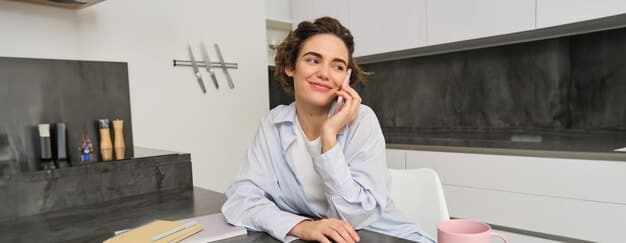Ace Virtual Interviews 2025: Land Your Dream Job

Mastering virtual interviews in 2025 requires a strategic blend of technological preparedness, refined communication skills, and authentic self-presentation to impress recruiters and secure the desired role.
In a dynamic job market, the virtual interview has become a cornerstone of the hiring process. This shift demands a refreshed approach, pushing candidates to adapt their strategies beyond traditional in-person interactions. Learning to Ace the Virtual Interview: Proven Techniques to Impress Recruiters and Land the Job in 2025 is not just an advantage; it’s a necessity for aspiring professionals.
Mastering the Virtual First Impression
The virtual first impression begins long before you greet your interviewer. It encompasses everything from your digital footprint to the technical setup of your interview space. Understanding these nuances is crucial for setting the right tone and projecting professionalism.
Technical Readiness: Your Digital Stage
Ensuring your technology is flawless is the bedrock of a successful virtual interview. Nothing disrupts the flow of conversation or your confidence more than technical glitches. A stable internet connection, a quiet environment, and fully charged devices are non-negotiable foundations.
- Internet Stability: Test your Wi-Fi or, better yet, use a wired Ethernet connection for maximum reliability.
- Audio and Video Check: Use a high-quality external microphone and webcam if available; if not, ensure your device’s built-in components are functioning optimally.
- Software Familiarity: Download and test the interview platform (Zoom, Teams, Google Meet) well in advance to avoid last-minute installations or troubleshooting.
Beyond the technical side, consider the aesthetics of your background. A cluttered or distracting environment can detract from your message. Opt for a clean, professional, and well-lit space that allows recruiters to focus solely on you, not your surroundings. Natural light is often the most flattering, but ensure it doesn’t create harsh shadows or glare on your screen.
Professional Appearance: Dressing for the Screen
While you might be in your home, the dress code for a virtual interview remains largely the same as for an in-person meeting. Your appearance communicates professionalism and respect for the opportunity. Choose attire that is clean, wrinkle-free, and appropriate for the industry and role you are applying for.
The upper half of your body is what will be most visible, so pay particular attention to your top and grooming. Solid colors often photograph better than busy patterns. Remember that confidence radiates from feeling prepared, and a polished appearance contributes significantly to that feeling.
Ultimately, a strong virtual first impression is a symphony of preparedness. It signals to the interviewer that you are detail-oriented, serious about the opportunity, and capable of handling remote interactions effectively. This blend of technical acumen and thoughtful presentation paves the way for a compelling interview experience.
Crafting Your Virtual Communication Strategy
Virtual communication presents unique challenges and opportunities. Without the full spectrum of in-person cues, clear articulation, intentional body language, and active listening become even more critical. Developing a robust communication strategy is key to conveying your message effectively and building rapport through the screen.
Mastering Non-Verbal Cues on Camera
Your non-verbal communication speaks volumes, even in a two-dimensional setting. Eye contact, posture, and facial expressions must be consciously managed to project engagement and confidence. Position your camera at eye level so that when you look into it, you create the illusion of direct eye contact with your interviewer.
- Eye Contact: Look directly into the camera when speaking, rather than at your own image or the interviewer’s face on the screen.
- Posture: Sit up straight, shoulders back, to project alertness and engagement. Avoid slouching.
- Facial Expressions: Maintain a natural, pleasant facial expression. Smile genuinely when appropriate to convey warmth and enthusiasm.
It’s easy to get distracted by your own image in a virtual meeting, but consistent eye contact with the camera fosters a stronger connection. Practice this technique beforehand to make it feel natural. Remember, your goal is to replicate the feeling of an in-person conversation as closely as possible.
Articulating Your Value Proposition Clearly
Clarity and conciseness are paramount in virtual interviews. With potential for technical delays or dropped words, every sentence must count. Prepare your answers to common interview questions, focusing on the STAR method (Situation, Task, Action, Result) to provide structured and impactful responses.

Avoid rambling or using jargon that might not be familiar to the interviewer. Practice distilling your experiences and skills into compelling narratives that directly address the job requirements. Your value proposition should be evident in every answer, demonstrating how your unique contributions align with the organization’s needs.
Engage in active listening by nodding, making appreciative sounds, and taking brief notes. This shows respect and ensures you fully understand each question before formulating your response. A strong virtual communication strategy marries careful preparation with authentic, responsive interaction.
Leveraging Technology to Your Advantage
In 2025, technology is not merely a tool for virtual interviews; it’s an integral part of the interview itself. Understanding how to leverage various digital resources and platforms can significantly enhance your performance, allowing you to showcase not only your skills but also your adaptability and tech-savviness.
Utilizing Digital Portfolios and Screen Sharing
Gone are the days of printing out physical portfolios. Virtual interviews offer a seamless way to share your work through digital means. Consider having a well-organized digital portfolio that you can easily access and share via screen-sharing features on the interview platform. This could include samples of your writing, design projects, code repositories, or links to relevant online projects.
- Prepare Relevant Artifacts: Curate specific examples that directly relate to the job role and company.
- Practice Screen Sharing: Familiarize yourself with the screen-sharing function of the platform to ensure a smooth, professional transition.
- Walk Through Your Work: Don’t just share; explain your process, contributions, and the outcomes achieved, much like you would in a presentation.
The ability to fluidly navigate and present your work demonstrates both your technical competence and your proactive nature. It turns a static conversation into an interactive showcase of your capabilities, leaving a lasting impression on the interviewer.
Navigating AI-Powered Interview Tools
As we move further into 2025, more companies are likely to incorporate AI-powered tools in their initial screening processes. These tools might analyze your facial expressions, vocal tone, keyword usage, and even response patterns. While this might seem daunting, understanding their function can help you prepare.
Focus on clear enunciation, maintaining a consistent, confident tone, and naturally integrating keywords from the job description into your responses. Practice answering questions aloud to yourself or record yourself to identify any speaking habits that could be misinterpreted by AI. Remember, these tools are often designed to flag potential candidates for human review, so authenticity remains key.
Leveraging technology effectively means being prepared for both the human and algorithmic elements of the modern interview. It’s about demonstrating your comfort with digital tools while ensuring your genuine personality and professional strengths shine through, irrespective of the medium.
Strategic Preparation Beyond the Basics
Beyond technical setups and polished communication, strategic preparation delves deeper into understanding the company, the role, and how you fit into the larger picture. This level of foresight allows you to answer questions with precision and ask insightful questions that demonstrate genuine interest and critical thinking.
In-Depth Company and Role Research
The internet provides a wealth of information about any prospective employer. Go beyond the “About Us” page. Look into recent news, press releases, company values, and their presence on social media. Understand their industry position, recent achievements, and any challenges mentioned. This helps you tailor your responses to align with their specific context.
Similarly, dissect the job description. Identify key responsibilities, required skills, and personality traits they seek. Think about specific examples from your past experiences that directly address each of these points. The more you connect your qualifications to their needs, the more compelling your candidacy becomes.
Consider using platforms like LinkedIn to research the interviewer(s). Understanding their background and role within the company can help you personalize your conversation and find common ground. This shows a proactive and thorough approach to your interview preparation.

Anticipating and Articulating Behavioral Responses
Behavioral questions, often starting with “Tell me about a time when…”, are designed to assess your past actions and predict future performance. Here, the STAR method is your best friend. Prepare several compelling stories that highlight your problem-solving, teamwork, leadership, and adaptability skills.
- Situation: Briefly set the scene.
- Task: Describe the goal you had to achieve.
- Action: Detail specific steps you took.
- Result: Explain the positive outcome and what you learned.
Practice articulating these stories concisely and impactfully. The goal is not just to recount an event but to demonstrate how you handled it, what you learned, and how that experience makes you a stronger candidate for the current role. Have a variety of stories ready so you can choose the most relevant one for each question.
Strategic preparation means thinking critically about how your unique experiences and skills can solve the company’s problems and contribute to their success. It’s about building a narrative that positions you as the ideal candidate, well before the interview begins.
Interactive Engagement: Asking the Right Questions
An interview is a two-way street. Your questions are as important as your answers, demonstrating your curiosity, critical thinking, and genuine interest in the role and the company culture. Asking insightful questions can significantly elevate your candidacy, turning a standard interview into a memorable conversation.
Probing Beyond Surface-Level Inquiries
Avoid asking questions that can be easily answered by a quick search on the company’s website. Instead, focus on queries that reveal deeper insights into the role, team dynamics, company culture, and future trajectory. These types of questions show you’ve done your homework and are thinking strategically about your potential contribution.
- Role Clarity: “What does success look like for this role in the first 90 days/6 months?”
- Team Dynamics: “How does this team collaborate, especially in a hybrid or remote environment?”
- Company Culture: “What are some of the biggest challenges this team or company is currently facing, and how are they being addressed?”
- Growth Opportunities: “What opportunities are there for professional development and growth within this role/company?”
These questions prompt elaborate responses from the interviewer, providing you with valuable information while simultaneously showcasing your sophisticated approach to career planning. They demonstrate that you’re not just looking for a job, but a meaningful opportunity to grow and contribute.
Responding to Interviewer Questions Strategically
Beyond asking your own questions, how you respond to the interviewer’s questions can also be a form of strategic engagement. If an interviewer asks “Do you have any questions for me?” and you’ve already covered some prepared questions, transition by saying, “Yes, I do. Building on your earlier point about [topic], I’m curious about [related, deeper question].”
This shows attentive listening and the ability to adapt your questions on the fly, transforming a rote Q&A into a genuine dialogue. Be prepared to ask follow-up questions based on their answers, indicating that you’re truly engaged in the conversation and processing the information in real-time.
The art of asking the right questions lies in turning passive listening into active engagement, making the interview a collaborative exploration rather than a simple interrogation. This approach leaves a lasting impression of a thoughtful, engaged, and genuinely interested candidate.
Post-Interview Etiquette and Follow-Up
The interview doesn’t end when you click ‘Leave Meeting’. The post-interview phase is just as critical, offering an opportunity to reiterate your interest, strengthen your candidacy, and leave a final, positive impression. Effective follow-up demonstrates professionalism, attention to detail, and continued enthusiasm for the role.
The Impactful Thank-You Note
A personalized thank-you note is a non-negotiable step. Send it within 24 hours of the interview. Avoid generic templates; instead, reference specific points discussed with each interviewer. Mention how their insights resonated with you or how a particular project they described aligns with your skills and aspirations.
- Personalize Each Note: Address each interviewer by name and reference something unique from your conversation with them.
- Reiterate Interest: Clearly state your continued enthusiasm for the role and the company.
- Reiterate Fit: Briefly connect your skills/experience to a key requirement or challenge of the role.
This thoughtful touch not only serves as a polite gesture but also as a powerful reminder of your qualifications and a subtle opportunity to reinforce why you are the ideal candidate. It can often tip the scales in your favor, especially when competing with similarly qualified candidates.
Navigating the Waiting Period Strategically
After sending your thank-you notes, the waiting game begins. It’s crucial to strike a balance between showing continued interest and being overly persistent. If the interviewer provided a timeline, respect it. If not, a polite follow-up email after a week or two (if you haven’t heard back) is generally acceptable.
This follow-up can be an opportunity to share a relevant article, a brief update on a project, or simply reaffirm your interest. Keep it concise and professional. Avoid multiple calls or emails unless explicitly instructed to do so. Trust that the hiring team is following their process, and your professional patience is also a part of your overall impression.
The post-interview phase is your final act of advocacy. By executing it with care and consideration, you reinforce your professional image and demonstrate the diligence that employers value, ultimately paving the way to landing your desired role.
| Key Point | Brief Description |
|---|---|
| 🖥️ Tech Setup | Ensure stable internet, quality audio/video, and a professional background. |
| 🗣️ Clear Communication | Practice eye contact with the camera and articulate responses using the STAR method. |
| 💡 Strategic Questions | Ask insightful questions about the role, team, and company culture. |
| ✉️ Timely Follow-Up | Send a personalized thank-you note within 24 hours to reinforce interest. |
Frequently Asked Questions About Virtual Interviews
Your background is crucial as it’s part of your visual presentation. Opt for a clean, tidy, and professional space that is free from distractions. A plain wall or a well-arranged bookshelf works well. Ensure good lighting, preferably natural light, to illuminate your face clearly without creating shadows.
Yes, discreetly using notes is generally acceptable, as long as it doesn’t distract you or the interviewer. Keep them concise and near your camera for quick glances. Notes can include key points, questions, or specific examples you want to share. Avoid reading directly from them, maintain eye contact, and appear natural.
Despite preparation, technical issues can happen. If they do, remain calm, apologize briefly, and try to resolve the issue quickly. If it persists, gracefully suggest switching to a phone call or rescheduling. Having a backup plan (like your phone number) ready is always a good idea to ensure continuity.
Practice by recording yourself responding to common interview questions. Pay attention to your verbal clarity, non-verbal cues (eye contact, posture, gestures), and overall pacing. You can also conduct mock interviews with a friend or career coach, specifically using the virtual format to simulate the experience realistically.
It’s generally best to let the interviewer bring up salary first, particularly in the initial stages. If they ask about your expectations, provide a range based on your research and experience. If it doesn’t come up by the advanced stages of the interview process, it’s appropriate to inquire about compensation and benefits.
Conclusion
Navigating the landscape of virtual interviews in 2025 demands a holistic approach, blending technical acuity with refined interpersonal skills. By meticulously preparing your environment, mastering on-screen communication, strategically leveraging digital tools, and maintaining diligent follow-up, you position yourself not just as a candidate, but as a future asset ready to thrive in today’s dynamic professional world. The virtual interview is more than a test of your qualifications; it’s an opportunity to showcase your adaptability and foresight in a digital-first era.





